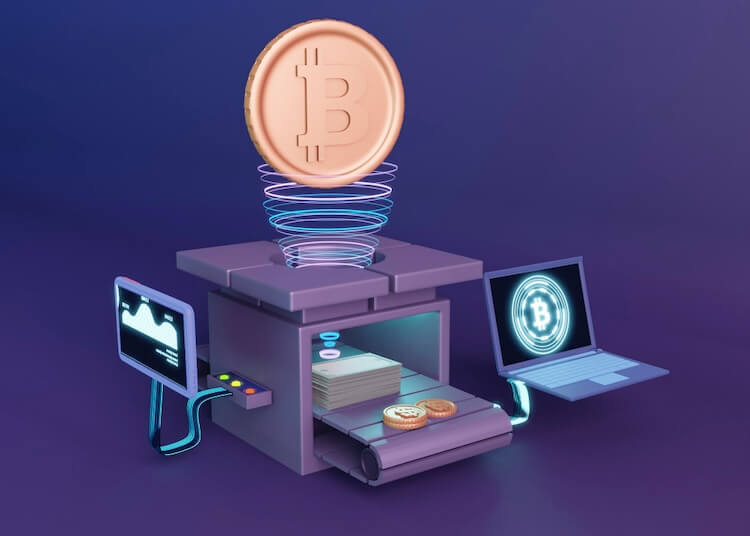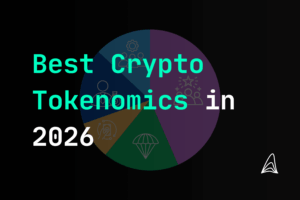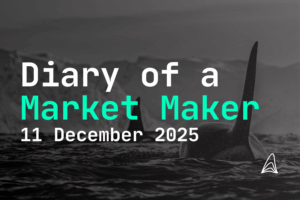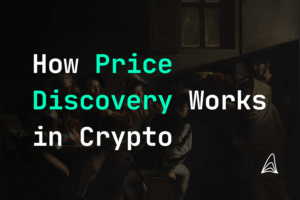
MEV - Maximal or Miner Extractable Value
- Jakob Brezigar
- Last updated: 23. November 2023
- Reading time: 8 min
Have you ever waited in line at a coffee shop, only to see someone jump ahead and snag the last croissant? That’s a bit like what happens in the blockchain world with Maximal Extractable Value (MEV). In essence, MEV is the digital equivalent of line-cutting, but instead of pastries, it’s about getting ahead in transaction queues. It’s a technique where savvy individuals or entities capitalize on the timing and ordering of blockchain transactions, extracting maximum value from these maneuvers, often at the expense of regular users.

Table of Contents
What exactly is MEV in the context of blockchain?
MEV, or Maximal Extractable Value, refers to the maximum profit someone can extract from the reordering, inclusion, or exclusion of transactions in a blockchain block, often exploiting the visibility of pending transactions for financial gain.
How does MEV affect everyday cryptocurrency users?
Everyday users may experience the effects of MEV as higher transaction fees (gas prices) and potential delays, as actors engage in strategies like frontrunning, impacting the overall market efficiency and fairness.
Can MEV be prevented or mitigated?
While MEV can’t be entirely prevented due to the nature of public blockchains, it can be mitigated through solutions like fair sequencing services, improved transaction privacy, and protocol changes that make exploitative practices less profitable or feasible.
Key Takeaways
Maximal Extractable Value (MEV) has evolved from a concept primarily concerning miners (Miner Extractable Value) to encompass a wider range of actors in blockchain networks, impacting transaction ordering and market prices.
MEV strategies, including frontrunning and sandwich attacks, exploit the visibility and timing of pending transactions, often leading to increased gas fees and market inefficiencies.
Advanced MEV tactics like generalized frontrunning use complex algorithms to anticipate market trends, requiring significant resources and expertise, thus favoring well-equipped participants in the blockchain space.
Decentralized exchanges (DEXs) are particularly vulnerable to MEV due to their inherent design, with network congestion and transparent transactions creating opportunities for MEV extraction and market manipulation.
While MEV drives innovation and development in blockchain technology, it also raises ethical concerns and risks such as market distortions, unfair advantages, and potential consensus instability in networks.
Experience With MEV from Our Industry Perspective
Diving into the MEV strategies is like reading a cyberpunk sci-fi novel Neuromancer, where computer hackers and super AI agents meet in cyberspace. Traders that run these strategies are MEV cowboys that look for bugs and exploits in open-source smart contracts and block builder implementations. They develop high-frequency trading bots that are arbing, front running and making DeFi finance more efficient. They can stay anonymous or not, what we can see is the extractable value collected in their public addresses. There is real money to be made here, if you can beat other MEV cowboys to become the fastest shark in the mempool. Get in touch if you want to know more experiences and perhaps even something more.
MEV History
Maximal Extractable Value (MEV), previously known as Miner Extractable Value, is a concept that has significantly impacted the blockchain network. Originating in the Ethereum ecosystem, MEV has evolved from a niche topic to a key consideration in blockchain technology and decentralized finance. It highlights the potential for certain actors, such as miners or block producers, to extract additional value from the ordering of (profitable) transactions within a blockchain block.
What does MEV Stand For?
MEV stands for Maximal Extractable Value, a term crucial in understanding the dynamics of blockchain networks and transaction ordering. Initially referred to as Miner Extractable Value, the concept has broadened to encompass a wider range of activities beyond miners, involving independent network participants and MEV searchers.
Maximal Extractable Value vs. Miner-Extractable Value
Essentially the two terms mean the same, as it is the same concept. The reason for two different names is that in the past the concept was most relevant for miners, whereas the term broadened to all users when other parties within the blockchain ecosystem started to exploit it. Maximal Extractable Value has evolved from Miner Extractable Value, reflecting a shift from miner-centric to a more inclusive understanding of value extraction methods in blockchain. This transition underscores the growing complexity and expansion of concept related strategies in the ecosystem.

What Is Maximal Extractable Value (MEV)?
Maximal Extractable Value (MEV) represents the potential profit that can be realized through the strategic manipulation of blockchain transaction ordering.
This concept has gained immense relevance in the fields of decentralized exchanges (DEXs) and decentralized finance (DeFi), where the ordering of transactions on the blockchain can have significant impacts on market price and the extraction of maximal extractable value. In essence, maximal extractable value is a byproduct of the unique mechanics of blockchain technology, where the transparent and immutable nature of the blockchain ledger opens up opportunities for actors to potentially benefit from the timing and order of transactions.

The implications of maximal extractable value extend beyond mere profit-making; they touch on the core principles of fairness and efficiency within the blockchain ecosystem. As such, understanding and addressing this concept is crucial for the ongoing development and maturation of networks in blockchain, particularly as they become more integrated with broader financial systems.
What is an MEV?
An MEV instance refers to a specific situation in which individuals or entities can extract value through their control or influence over the ordering of transactions within a blockchain. These opportunities for extracting MEV are particularly pronounced in scenarios marked by network congestion, where the sequence in which transactions are processed can critically influence their economic outcomes. In such congested networks, the ability to prioritize one’s transaction or to anticipate the transactions of others can lead to significant financial gain.

This aspect of the concept underscores the importance of equitable transaction processing and the potential risks associated with centralized control in decentralized systems. As blockchain technology continues to evolve, addressing the challenges posed by maximal extractable value MEV will be essential in maintaining the integrity and trustworthiness of decentralized networks.
How does MEV Work
It operates by capitalizing on the visibility and timing of pending transactions in a blockchain network. Actors with advanced algorithms or insider knowledge, such as MEV bots, can manipulate order of transactions for their benefit, often leading to high gas fees as they compete to place their transactions in advantageous positions.

What do the Pending Transactions Have to do With MEV?
Pending transactions are central to MEV as they provide a window into future market actions. By analyzing these transactions, actors can predict market trends and position their transactions, often leading to a higher gas price as they compete to exploit these opportunities.

What is an Example of MEV?
How does MEV Extraction Take Place?
MEV extraction is a process that involves various strategies to capitalize on the knowledge of pending transactions and the state of the transaction mempool.
Key methods include frontrunning, where actors strategically place their transactions ahead of others in the queue based on the information about pending transactions. This practice can lead to significant profits, especially in situations involving large trades or market-moving events. Additionally, such extraction can involve more complex schemes like transaction reordering or creating specific transaction bundles to maximize the extracted value.
The actors involved in extracting MEV range from individual traders to sophisticated entities using automated systems or dedicated bots. These actors continually scan the blockchain network, analyzing the transaction mempool for opportunities to extract MEV. As blockchain technology evolves, so too do the methods and complexities of MEV extraction, making it an ever-evolving challenge within the ecosystem.
Here are Several Examples of Tactics Used to Extract MEV
Arbitrage: Taking advantage of price differences across decentralized exchanges, often leading to profitable transactions.
Liquidation opportunities: Targeting positions on the verge of liquidation, especially when the value of borrowed assets exceeds the threshold.
Frontrunning: Capitalizing on the knowledge of future transactions to place one’s transaction in a more profitable position.
The Most Common MEV Attacks
Frontrunning and Sandwich Attacks
Frontrunning and Sandwich Attacks are prevalent in the realm of MEV, where knowledgeable actors manipulate the sequence of transactions for financial gain.
This manipulation often results in higher gas fees, impacting regular users who may find themselves paying more for their transactions to be processed. In a frontrunning scenario, an actor, having insight into a forthcoming transaction, places their transaction first to profit from the subsequent price movement.

Sandwich attacks take this a step further by placing transactions both before and after a known upcoming transaction, effectively ‘sandwiching’ it. This tactic maximizes profits by exploiting the price impact of the sandwiched transaction.
These strategies demonstrate the more predatory aspects of maximal extractable value concept, highlighting the need for measures to protect users from such exploitative practices. As blockchain networks continue to grow, addressing these types of attacks becomes crucial to maintaining a fair and efficient market.
Generalized Frontrunning
Generalized Frontrunning represents a more advanced form of MEV strategy, involving complex algorithms that predict not just individual transactions but also wider market trends. These algorithms enable actors to capitalize on such opportunities by positioning their transactions in response to anticipated market movements.
This approach can involve sophisticated analysis of transaction mempools, detecting profitable MEV opportunities, and executing transactions that maximize returns. Generalized frontrunning often requires significant computational resources and a deep understanding of market dynamics, making it a strategy primarily employed by well-resourced and knowledgeable participants in the blockchain space.
Uncle-Bandit Attacks
Uncle-Bandit attacks involve manipulating the blockchain to create situations where the same block number can be used to extract value, often at the cost of network stability.
Time-Bandit Attacks
Time-Bandit attacks exploit the blockchain’s timekeeping mechanisms, reordering transactions to benefit from MEV opportunities, thereby disrupting the natural flow of the blockchain network.
Is MEV Good or Bad?
The impact of MEV on blockchain ecosystems is multifaceted. While it introduces economic inefficiencies and potential ethical concerns, it also incentivizes the development of solutions like fair sequencing services and decentralized transaction ordering services to mitigate its negative aspects.
Exchange Arbitrage and Liquidations
Exchange Arbitrage and Liquidations represent key avenues for maxima extractable value MEV in DEX. These strategies involve identifying and exploiting price discrepancies between different exchanges or liquidating undercollateralized positions for a profit. In the fast-paced world of DeFi, price differences across various platforms can emerge quickly, and actors adept at MEV can leverage these opportunities to secure arbitrage profits.

Liquidations, on the other hand, occur when a user’s collateral value falls below a certain threshold, triggering an opportunity for others to liquidate that position at a favorable price. These MEV strategies highlight the dynamic and sometimes precarious nature of decentralized finance, where market efficiency and volatility can create both risks and opportunities for participants.
Decentralized Exchanges and MEV
DEXs are particularly susceptible to MEV due to their inherent design and operational mechanisms. These platforms, while offering advantages in terms of decentralization and user control, also often suffer from network congestion and latency issues. This environment is ideal for MEV extraction, as the transparent and immutable nature of blockchain transactions on DEXs allows actors to observe and react to pending transactions.

The liquidity models and automated market mechanisms of DEXs further compound this issue, as they can create predictable price movements that can be exploited. As such, the prevalence of MEV in DEX poses significant challenges and necessitates the development of solutions that can mitigate its impact while preserving the benefits of decentralized finance.
Potential Consensus Instability
A significant concern with MEV is its potential to cause consensus instability within blockchain networks. The pursuit of MEV can incentivize block producers to engage in practices that may compromise network integrity.
NFT MEV
NFT MEV represents a novel aspect of maximal extractable value,where the unique characteristics of non-fungible tokens create new opportunities and challenges in MEV extraction. The singular nature of NFTs can lead to specific MEV strategies, such as targeting high-value NFT transfers or releases, where the timing of transactions can significantly impact market price and MEV profits.
MEV Pros and Cons
MEV’s impact on the blockchain ecosystem is a blend of benefits and drawbacks. On the positive side, it drives innovation and encourages the development of more efficient blockchain protocols and smarter contract designs. This progress includes the creation of MEV mitigation tools like fair sequencing services and decentralized ordering of transactions services, aimed at reducing the negative aspects of MEV.

However, the quest for MEV can also introduce market distortions and unfair advantages. The ability to manipulate transaction ordering not only leads to higher gas fees but also raises ethical concerns about equality and transparency in blockchain networks. The strategies employed in MEV extraction, such as frontrunning, sandwich attacks, and transaction reordering, can create an uneven playing field, undermining the trust and participation in decentralized finance.
Moreover, the pursuit of MEV can lead to network congestion, as actors vie to place their transactions in the most advantageous positions. This competition not only increases transaction fees but can also slow down the overall processing speed of the network, affecting all network participants.
Disclaimer: The information provided in this article is for informational purposes only and does not constitute financial, investment, or other professional advice. All opinions expressed herein are solely those of the author and do not represent the views or opinions of any entity with which the author may be associated. Investing in financial markets involves risk, including the potential loss of principal. Readers should perform their own research and consult with a licensed financial advisor before making any investment decisions. Past performance is not indicative of future results.

Jakob Brezigar
Jakob, an experienced specialist in the field of cryptocurrency market making, boasts an extensive international presence. With Orcabay, he has skillfully managed major operations and deals for a wide array of global stakeholders.



